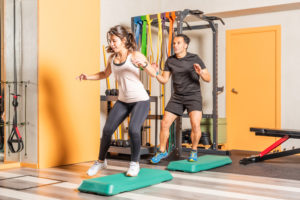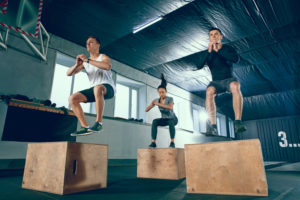7 Best Plyometric Exercises for Beginners (jump into fitness)

What the heck are plyometrics exercises and why should they be a part of your regular training regimen? Are there any plyometric exercises for beginners that can help you ease into this type of exercise?
It turns out that plyometrics are a wonderful form of training that can help fortify your strength and enhance your conditioning. And, yes, there are some fantastic moves for beginners to try.
What are Plyometrics?
Okay, so there are many different types of exercise, from isometrics to Pilates to resistance training to HIIT cardio.
So, what on earth are plyometrics? Plyometrics consists of a number of jumping exercises that help you improve your strength, your speed, and your ability to exercise for longer periods. The exercises use types of jumps to work on your explosiveness and your agility, developing and growing the necessary muscle fibers for these types of movements.
In general, most athletes will focus on sport-specific types of jumping exercises. For example, basketball players who need to improve their vertical jumps will do plyometrics involving vertical movements. A running back, on the other hand, might want to focus on propelling himself forward with speed and force and would thus work on forward-moving plyometric jumping exercises.
Benefit of Plyometrics
Plyometrics can help you enhance your power, strength, speed, and ability, but their real value comes in the benefits they provide your muscles, joints, tendons, and nervous system.
Building fast-twitch muscle fibers is important for converting your muscular strength into speed and agility. It’s great to be big and strong, but if you can’t move, the benefits of all that strength are limited.
That said, along with boosting the strength of your muscles comes the care and attention due your tendons and joints. As these need to be able to keep up with, and move seamlessly with, your muscles, it’s critical that they be included in training protocols. Engaging in plyometric exercises for beginners can help you work on elasticity, flexibility, muscle contraction efficiency, and the number and strength of your fast-twitch fibers.
A stronger, quicker battle-tested physique can go a long way toward preventing injury, too, reducing your risks of setbacks while participating in heavy strenuous training.
Try These Easy Plyometric Exercises for Beginners
Perhaps “easy” is a misnomer as these exercises are relatively straightforward but difficult in terms of exertion. But here are 7 great plyometric exercises for beginners to add to their fitness routine.
1. Scissor Jumps
Start by standing with your right foot in front of your body and your left foot behind you. Your right arm will be behind your body and your left arm forward (the opposite positions of your legs). Take a giant jump up into the air and scissor-kick your legs and arms to switch positions midair. Land softly with slightly bent knees. Your left foot and right arm should now be in front with your right leg and left arm toward the rear of your body. Repeat.
2. Plank Side Hops

Try these to bring the plank movement to a whole new level of difficulty. Start in a plank position but get up onto your hands with your arms about shoulder-width apart and your palms down. Your legs will be outstretched and you’ll be up on your toes. Push through your toes to jump your legs and lower body up off the ground, bending your knees as you move your lower body all the way to the left. Land as softly as you can and then repeat the movement to shift your body to the right. Repeat.
3. Burpees

You’ve probably heard these mentioned with a certain amount of dread, with good reason. Start by standing with your feet about hip-width apart and bend down until you are in a deep squat position. Next, tip your upper body forward and place your hands on the ground in front of you, shoulder-width apart. Kick your feet out behind you so that you are in a pushup position; lower your upper body to the ground to complete a pushup. When done, jump your feet back up underneath your hips and propel yourself up to standing again, and end with a final jump. Repeat.
4. Lateral Jumps

Start by standing with your hands held loosely in front of you and balance on your right foot. Bend at the knee and then push up forcefully through the balls of your foot to jump up and land on your left foot. Repeat the same motion to squat and then jump back to the right side. Repeat. For an extra challenge, you can add a step to leap over.
5. Plyometric Pushups
These are a little bit on the tough side, so feel free to start these while on your knees for added support. Begin in a pushup position with your body straight, up on your toes (or knees) with your arms straight and aligned under your shoulders, palms on the ground. Lower your upper body toward the ground by bending at the elbows to go into the downward portion of a pushup position. Next, by pushing up and straightening your arms with explosive force, propel your upper body off the ground (clap if you can) so that your hands come off the ground before landing with gently bent elbows back onto your palms. Repeat.
6. Box Jumps

Yup, just like it sounds, this involves jumping up onto a box and then stepping back down onto the ground to repeat the jumping motion again. Start with a relatively low box and stand with your feet about hip-width apart in front of it. Next, squat down and then propel yourself up and forward to jump onto the box surface in front of you. Progress to higher boxes as you get more comfortable with this jump.
7. Squat Tucks
Burn a lot of extra calories with this staple of a plyometric exercise. Start with your feet about hip-width apart and squat down with your hands held loosely in front of you. Next, jump up explosively into the air, bringing your knees up toward your chest as you jump and your hands slightly overhead. Try to land as softly as you can, keeping your knees pliable as you land. Repeat.
Safety is Crucial
Safety is a big concern with any exercise, and even more so with plyometrics to ensure you stay injury-free.
Maintaining good posture and protecting the hip flexor muscles can help prevent discomfort. If you do, however, find that your muscles are feeling tight or starting to feel painful, back off, reduce intensity, cut down on repetitions, or even remove the jumping altogether. There are helpful modifications you can use as you build up the strength, elasticity, and agility to push harder.
Even then, please avoid overdoing it as overtraining is one of the leading causes of sports injury. Instead, focus on doing the exercise correctly with greater power rather than pushing for more reps as you get tired. In other words, focus on quality rather than quantity.
Remember to warm up and stretch well, progress slowly, and give your body time to recover and get stronger both between sets and exercises and between workouts.
Also, choose a jumping surface with more give. For example, avoid hard surfaces like concrete and asphalt. Instead, look for rubber mats, firm natural grass, or suspended floors with some shock absorption. Uneven surfaces should also be avoided.
High-impact plyometrics exercises are typically not recommended for prepubescent athletes, as their bones are still forming. Older individuals as well as those who are overweight or are just beginners may also want to limit plyometrics and ensure they’re combined with other types of training to build up enough speed and strength to perform the exercises correctly.
That said, when gradually integrated into your balanced workout program, plyometric exercises for beginners can be a fun, effective addition to build power, speed, and agility!





 7 Signs Your Body is Seriously Low on Collagen (not just wrinkles)
7 Signs Your Body is Seriously Low on Collagen (not just wrinkles) Health Expert: "Turmeric Doesn't Work (unless...)"
Health Expert: "Turmeric Doesn't Work (unless...)" 3 Warning Signs Your Probiotic Supplement is a Total Waste
3 Warning Signs Your Probiotic Supplement is a Total Waste

